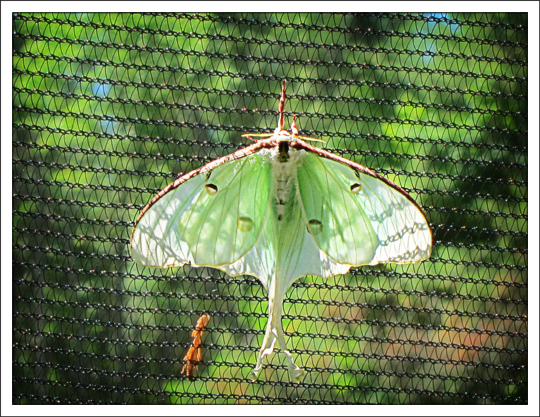Moths of the Adirondack Mountains:
Luna Moth (Actias luna)
 Moths of the Adirondack Mountains: Luna Moth in the Paul Smiths VIC Butterfly House (30 June 2012)
Moths of the Adirondack Mountains: Luna Moth in the Paul Smiths VIC Butterfly House (30 June 2012)
| This page is no longer being updated. For an updated version of this material, see: Luna Moth (Actias luna). |
The Luna Moth (Actias luna) is a large nocturnal moth that may be seen in the Adirondack Mountains of upstate New York and in the Paul Smiths VIC Butterfly House in June.[1] It is a member of the family Saturniidae, so named because some of the members of this family have concentric rings reminiscent of the planet Saturn. The Luna Moth was named for its moon-like spots. [2] The Luna Moth was featured on a first-class US postage stamp issued in 1987. [3]
The body and wings of the Luna Moth are pale lime green. Each wing has a transparent eyespot. [4] The front margins of the front wings have a reddish to dark brown border. Each of the hind wings extend into a curving long tail. The inner border of the hind wing is pale yellow. [5] This moth generally rests with its wings flat. [6]
Adult Luna Moths are strong fliers and, like many moths, are attracted to lights. [7] Mating generally takes place after midnight, with egg-laying beginning that evening. [8] Females lay their eggs either singly or in small groups on host plant leaves. Eggs hatch in about a week. Caterpillar hosts include white birch, hickories, walnuts and sumacs. [9] Adult Lunas do not feed; their only mission is to reproduce. They generally live for about a week. [10]
The range of the Luna Moth includes every eastern state (including New York State) from Maine south to Florida and west to eastern Texas and eastern North Dakota. [11] [12] The Luna lives in deciduous hardwood forests. [13] [14]
In 2012, Luna Moths were seen in the northern Adirondacks from late May through late June. [15] In 2012, this insect was present in the Paul Smiths VIC Native Species Butterfly House from opening day on 9 June to the end of June. [16]
References
- Susan Grimm Hanley. Interpretive Naturalist, Paul Smith's College Native Species Butterfly House. Species Logbooks.
- Butterflies and Moths of North American. Species Profiles. Sighting record: 6/14/12, 6/28/12, 6/30/12
- ENature. Field Guides.
- Project Silkmoth. Luna Moth.
- Project Silkmoth. 2012 Sightings Map.
- Iowa State University. Department of Entomology. BugGuide.
- Insect Images. Luna Moth.
- University of Michigan. Animal Diversity Web.
- University of Florida. Department of Entomology and Nematology. Featured Creatures.
- Charles V. Covell, Jr. A Field Guide to the Moths of Eastern North America (Houghton Mifflin Company, 1984), p. 49.
- David Carter. Butterflies and Moths (Dorling Kindersley, Inc., 1992), p. 222.
- David Beadle and Seabrooke Leckie. Peterson Field Guide to Moths of Northeastern North America (Houghton Mifflin Harcourt Publishing Company, 2012), pp. 254-255.
